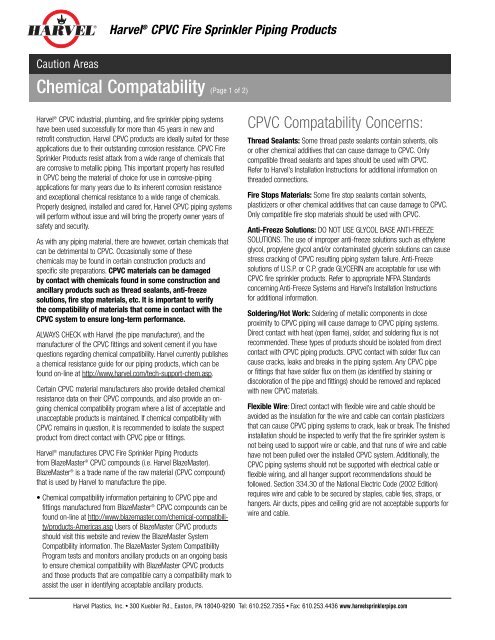Fire Protection Design Manual - Office of Construction and Facilities ...
Fire Protection Design Manual - Office of Construction and Facilities ...
Fire Protection Design Manual - Office of Construction and Facilities ...
You also want an ePaper? Increase the reach of your titles
YUMPU automatically turns print PDFs into web optimized ePapers that Google loves.
Caution Areas<br />
Harvel ® CPVC <strong>Fire</strong> Sprinkler Piping Products<br />
Chemical Compatability (Page 1 <strong>of</strong> 2)<br />
Harvel ® CPVC industrial, plumbing, <strong>and</strong> fire sprinkler piping systems<br />
have been used successfully for more than 45 years in new <strong>and</strong><br />
retr<strong>of</strong>it construction. Harvel CPVC products are ideally suited for these<br />
applications due to their outst<strong>and</strong>ing corrosion resistance. CPVC <strong>Fire</strong><br />
Sprinkler Products resist attack from a wide range <strong>of</strong> chemicals that<br />
are corrosive to metallic piping. This important property has resulted<br />
in CPVC being the material <strong>of</strong> choice for use in corrosive-piping<br />
applications for many years due to its inherent corrosion resistance<br />
<strong>and</strong> exceptional chemical resistance to a wide range <strong>of</strong> chemicals.<br />
Properly designed, installed <strong>and</strong> cared for, Harvel CPVC piping systems<br />
will perform without issue <strong>and</strong> will bring the property owner years <strong>of</strong><br />
safety <strong>and</strong> security.<br />
As with any piping material, there are however, certain chemicals that<br />
can be detrimental to CPVC. Occasionally some <strong>of</strong> these<br />
chemicals may be found in certain construction products <strong>and</strong><br />
specific site preparations. CPVC materials can be damaged<br />
by contact with chemicals found in some construction <strong>and</strong><br />
ancillary products such as thread sealants, anti-freeze<br />
solutions, fire stop materials, etc. It is important to verify<br />
the compatibility <strong>of</strong> materials that come in contact with the<br />
CPVC system to ensure long-term performance.<br />
ALWAYS CHECK with Harvel (the pipe manufacturer), <strong>and</strong> the<br />
manufacturer <strong>of</strong> the CPVC fittings <strong>and</strong> solvent cement if you have<br />
questions regarding chemical compatibility. Harvel currently publishes<br />
a chemical resistance guide for our piping products, which can be<br />
found on-line at http://www.harvel.com/tech-support-chem.asp.<br />
Certain CPVC material manufacturers also provide detailed chemical<br />
resistance data on their CPVC compounds, <strong>and</strong> also provide an ongoing<br />
chemical compatibility program where a list <strong>of</strong> acceptable <strong>and</strong><br />
unacceptable products is maintained. If chemical compatibility with<br />
CPVC remains in question, it is recommended to isolate the suspect<br />
product from direct contact with CPVC pipe or fittings.<br />
Harvel ® manufactures CPVC <strong>Fire</strong> Sprinkler Piping Products<br />
from BlazeMaster ® CPVC compounds (i.e. Harvel BlazeMaster).<br />
BlazeMaster ® is a trade name <strong>of</strong> the raw material (CPVC compound)<br />
that is used by Harvel to manufacture the pipe.<br />
• Chemical compatibility information pertaining to CPVC pipe <strong>and</strong><br />
fittings manufactured from BlazeMaster ® CPVC compounds can be<br />
found on-line at http://www.blazemaster.com/chemical-compatibility/products-Americas.asp<br />
Users <strong>of</strong> BlazeMaster CPVC products<br />
should visit this website <strong>and</strong> review the BlazeMaster System<br />
Compatibility information. The BlazeMaster System Compatibility<br />
Program tests <strong>and</strong> monitors ancillary products on an ongoing basis<br />
to ensure chemical compatibility with BlazeMaster CPVC products<br />
<strong>and</strong> those products that are compatible carry a compatibility mark to<br />
assist the user in identifying acceptable ancillary products.<br />
CPVC Compatability Concerns:<br />
Thread Sealants: Some thread paste sealants contain solvents, oils<br />
or other chemical additives that can cause damage to CPVC. Only<br />
compatible thread sealants <strong>and</strong> tapes should be used with CPVC.<br />
Refer to Harvel’s Installation Instructions for additional information on<br />
threaded connections.<br />
<strong>Fire</strong> Stops Materials: Some fire stop sealants contain solvents,<br />
plasticizers or other chemical additives that can cause damage to CPVC.<br />
Only compatible fire stop materials should be used with CPVC.<br />
Anti-Freeze Solutions: DO NOT USE GLYCOL BASE ANTI-FREEZE<br />
SOLUTIONS. The use <strong>of</strong> improper anti-freeze solutions such as ethylene<br />
glycol, propylene glycol <strong>and</strong>/or contaminated glycerin solutions can cause<br />
stress cracking <strong>of</strong> CPVC resulting piping system failure. Anti-Freeze<br />
solutions <strong>of</strong> U.S.P. or C.P. grade GLYCERIN are acceptable for use with<br />
CPVC fire sprinkler products. Refer to appropriate NFPA St<strong>and</strong>ards<br />
concerning Anti-Freeze Systems <strong>and</strong> Harvel’s Installation Instructions<br />
for additional information.<br />
Soldering/Hot Work: Soldering <strong>of</strong> metallic components in close<br />
proximity to CPVC piping will cause damage to CPVC piping systems.<br />
Direct contact with heat (open flame), solder, <strong>and</strong> soldering flux is not<br />
recommended. These types <strong>of</strong> products should be isolated from direct<br />
contact with CPVC piping products. CPVC contact with solder flux can<br />
cause cracks, leaks <strong>and</strong> breaks in the piping system. Any CPVC pipe<br />
or fittings that have solder flux on them (as identified by staining or<br />
discoloration <strong>of</strong> the pipe <strong>and</strong> fittings) should be removed <strong>and</strong> replaced<br />
with new CPVC materials.<br />
Flexible Wire: Direct contact with flexible wire <strong>and</strong> cable should be<br />
avoided as the insulation for the wire <strong>and</strong> cable can contain plasticizers<br />
that can cause CPVC piping systems to crack, leak or break. The finished<br />
installation should be inspected to verify that the fire sprinkler system is<br />
not being used to support wire or cable, <strong>and</strong> that runs <strong>of</strong> wire <strong>and</strong> cable<br />
have not been pulled over the installed CPVC system. Additionally, the<br />
CPVC piping systems should not be supported with electrical cable or<br />
flexible wiring, <strong>and</strong> all hanger support recommendations should be<br />
followed. Section 334.30 <strong>of</strong> the National Electric Code (2002 Edition)<br />
requires wire <strong>and</strong> cable to be secured by staples, cable ties, straps, or<br />
hangers. Air ducts, pipes <strong>and</strong> ceiling grid are not acceptable supports for<br />
wire <strong>and</strong> cable.<br />
Harvel Plastics, Inc. • 300 Kuebler Rd., Easton, PA 18040-9290 Tel: 610.252.7355 • Fax: 610.253.4436 www.harvelsprinklerpipe.com

















